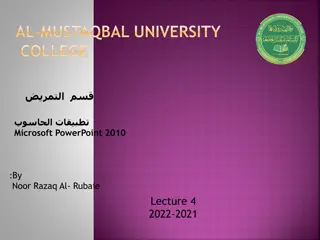
Uncovering Human History through Archaeology
Archaeology is the study of human history through excavating sites, studying artifacts, and piecing together evidence like a detective. Archaeologists meticulously uncover buried structures and artifacts, such as tools, weapons, pottery, artwork, and jewelry, providing insights into past civilizations. Tutankhamun's Tomb, excavated by Howard Carter in 1922, is a remarkable example of the meticulous work done by archaeologists in uncovering ancient treasures buried beneath the ground.
Uploaded on | 1 Views
Download Presentation

Please find below an Image/Link to download the presentation.
The content on the website is provided AS IS for your information and personal use only. It may not be sold, licensed, or shared on other websites without obtaining consent from the author. If you encounter any issues during the download, it is possible that the publisher has removed the file from their server.
You are allowed to download the files provided on this website for personal or commercial use, subject to the condition that they are used lawfully. All files are the property of their respective owners.
The content on the website is provided AS IS for your information and personal use only. It may not be sold, licensed, or shared on other websites without obtaining consent from the author.
E N D
Presentation Transcript
Archaeology Archaeology is the study of human history. It involves excavating sites and studying buildings and artefacts, which are primary sources of information. The people who do this work are called archaeologists.
Archaeologist An archaeologist does a range of jobs, including researching, digging, describing and classifying. They work like a detective, piecing together evidence to get a clearer picture of the past.
Archaeological sites The first job is to identify a site to excavate! The site will be an area of historical interest. Some archaeological sites, such as Pompeii, are visible at ground level.
Archaeological sites Other archaeological sites are buried deep beneath the ground. An example of this type of site is Tutankhamun s Tomb, Egypt.
Tutankhamuns Tomb This tomb had remained undisturbed at 8 metres below the ground for over 3,000 years, until the archaeologist Howard Carter excavated it in 1922. It took Carter and his team of archaeologists over 15 years to classify the thousands of artefacts they found in Tutankhamun s Tomb.
Excavation When excavating a site, the archaeologist must dig in a slow and systematic way to avoid damaging artefacts buried in the soil.
Archaeological tools They use a range of tools, such as shovels, picks, trowels, sieves and buckets, and smaller items such knives and brushes.
Archaeological discoveries They are really hoping to uncover buried structures, or artefacts such as tools, weapons, pottery, artwork and jewellery.
Artefacts Artefacts help us to understand how people lived in the past. For example, grinding stones provide clues about what people ate and how they prepared their food.
Archaeological collaboration An archaeologist often works closely with other experts, such as a zoologist, a geologist or a botanist to find out what was going on in the past by examining animal remains, soil samples or plant material such as pollen.
Archaeological techniques To work out the age of an object containing organic material such as wood, scientists use a technique called carbon dating.
Archaeology in Ireland There is no shortage of sites of historical interest in Ireland, including passage tombs such as Newgrange in Co. Meath. Did you know that this passage tomb lay buried beneath farmland until it was excavated by archaeologists in the 1960s? Imagine what else is waiting to be uncovered!
Photos/Illustrations Shutterstock




















